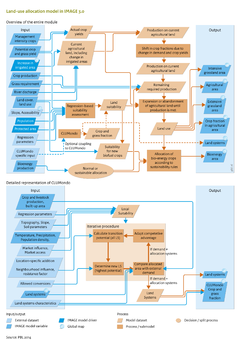Land-use allocation/Description: Difference between revisions
Jump to navigation
Jump to search
No edit summary |
No edit summary |
||
| Line 1: | Line 1: | ||
{{ComponentDescriptionTemplate | {{ComponentDescriptionTemplate | ||
|Reference=Van Asselen and Verburg, 2013; Alexandratos and Bruinsma, 2012; Klein Goldewijk et al., 2010; O'Neill, 2013; Lambin et al., 2000; Doelman and Stehfest, in preparation; | |Reference=Van Asselen and Verburg, 2013; Alexandratos and Bruinsma, 2012; Klein Goldewijk et al., 2010; O'Neill, 2013; Lambin et al., 2000; Doelman and Stehfest, in preparation; IIASA and FAO, 2012; Nelson, 2008; Klein Goldewijk et al., 2011; Letourneau et al., 2012; | ||
|Description=IMAGE 3.0 has two methods to represent land-use dynamics and to determine the location of new agricultural lands. For applications not focusing on land-use dynamics, a simple regression-based suitability assessment is used to determine future land-use patterns. A dynamic link to CLUMondo ([[Van Asselen and Verburg, 2013]]) enables more detailed representation of land-use systems and their dynamics. Both approaches are embedded in the IMAGE land-use allocation model (see flowchart). | |Description=IMAGE 3.0 has two methods to represent land-use dynamics and to determine the location of new agricultural lands. For applications not focusing on land-use dynamics, a simple regression-based suitability assessment is used to determine future land-use patterns. A dynamic link to CLUMondo ([[Van Asselen and Verburg, 2013]]) enables more detailed representation of land-use systems and their dynamics. Both approaches are embedded in the IMAGE land-use allocation model (see flowchart). | ||
Revision as of 19:07, 16 May 2014
Parts of Land-use allocation/Description
| Component is implemented in: |
| Components: |
| Related IMAGE components |
| Projects/Applications |
| Key publications |
| References |
